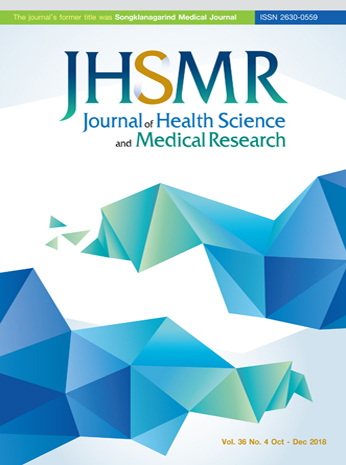Prevalence of Violence among High School Students in Hat Yai Municipality, Southern Thailand: ICAST-CI Thai Version Study
DOI:
https://doi.org/10.31584/jhsmr.2018.36.4.20Keywords:
physical violence, psychological violence, school violence, sexual violence victimizationAbstract
Objective: To determine the prevalence and risk factors of school violence among Thai high school students using a Thai version of the International Society for the Prevention of Child Abuse and Neglect (ISPCAN) Child Abuse Screening Tool-Children: Institute Version (ICAST-CI).
Material and Methods: A cross-sectional study was conducted at two high schools in Hat Yai municipality, Songkhla, southern Thailand with 480 students. Univariate logistic regression analysis was used to assess the risk factors associated with school violence.
Results: Overall, 88.8% of the students reported experiencing violence at school in their lifetimes. The prevalences of psychological, physical and sexual violence were 84.0%, 66.9% and 30.6%, respectively. The most commonly reported violence patterns among each form of violence were swearing (87.8%), slapping on hand/arm (66.4%), and showing pornography (67.3%), respectively. Students with good school performance tended to report psychological violence [odds ratio (OR)=3.03, 95% confidence interval (CI)=1.13-8.07] whereas students aged >15 years were less likely to report physical violence (OR=0.47, 95% CI=0.31-0.71). Sexual violence was reported more among male students (OR=1.71, 95% CI= 1.12-2.61) and students aged >15 years regardless of gender (OR=1.58, 95% CI=1.04-2.39). Students were more likely to be reported as a perpetrator than teachers in most patterns of violence.
Conclusion: The prevalence of school violence among high school students in Hat Yai municipality, southern Thailand, is significant. and the patterns of violence are similar to other ICAST-CI studies. Violence at school should be recognized as a serious problem, and preventive measures should be implemented nationwide.
References
2. Pinheiro P. World report on violence against children [mono graph on the Internet]. Geneva: ATAR Roto Presse SA; 2006 [cited 2017 Sept 30]. Available from: https://www.unicef.org/violencestudy/
3. Pengpid S, Peltzer K. Bullying and its associated factors among school-aged adolescents in Thailand. Scientific World J 2013; 2013:2543083. DOI: 10.1155/2013/254083.
4. Pradubmook-Sherer P, Sherer M. In the shadow of terror: high school youth violence in Thailand. J Family Violence 2014;29:783-95.
5. Zolotor AJ, Runyan DK, Dunne MP, Jain D, Peturs HR, Ramirez C, et al. ISPCAN Child Abuse Screening Tool Children’s Version (ICAST-C): Instrument development and multi-national pilot testing. Child Abuse Negl 2009;33:833-41.
6. Ribeiro IMP, Ribeiro AST, Pratesi R, Gandolfi L. Prevalence of various forms of violence among school students. Acta Paul Enferm 2015;28:54-9.
7. Lynch MA, Saralidze L, Goduadze N, Zolotor A. National study on violence against children in Georgia [monograph on the Internet]. Tbilisi: Unicef Georgia; 2007 [cited 2017 Jan 31]. Available from: https://www.unicef.org/georgia/Violence_Study_ ENG_final.pdf
8. Ministry of Social Development and Human Security, Thailand. National study on violence against children in Thailand: high school students. (Vol. 3). Bangkok: The Ministry; 2012.
9. Lockwood D. Violence among middle school and high school students: analysis and implications for prevention [homepage on the Internet]. Washington DC: US Department of Justice; 1997 [cited 2017 Jan 31]. Available from: https://www.ncjrs.gov/pdffiles/166363.pdf
10. Skiba RJ, Peterson RL. School discipline at a crossroads: from zero tolerance to early response. Except Child 2000;66:335- 46.
11. Chen JK, Astor RA. The perpetration of school violence in Taiwan: an analysis of gender, grade level and school type. Sch Psychol Int 2009;30:568-84.
12. Chen JK, Astor RA. School violence in Taiwan: examining how western risk factors predict school violence in an Asian culture. J Interpers Violence 2010;25:1388-410.
13. Khoury-Kassabri M, Benbenishty R, Astor RA, Zeira A. The contributions of community, family, and school variables to student victimization. Am J Comm Psychol 2004;34:187-204.
14. Felix ED, Furlong MJ, Austin G. A cluster analytic investigation of school violence victimization among diverse students. J Interpers Violence 2009;24:1673-95.
15. Basch CE. Aggression and violence and the achievement gap among urban minority youth. J Sch Health 2011;81:619-25.
16. Stephenson R, Sheikhattari P, Assasi N, Eftekhar H, Zamani Q, Maleki B, et al. Child maltreatment among school children in the Kurdistan Province, Iran. Child Abuse Negl 2006;30:231- 45.
17. Devries KM, Child JC, Allen E, Walakira E, Parkes J, Naker D. School violence, mental health, and educational performance in Uganda. Pediatrics 2014;133:e129-37.
18. Nakamoto J, Schwartz D. Is peer victimization associated with academic achievement? A meta-analytic review. Soc Dev 2010;19:221-42.
19. Global Initiative to End All Corporal Punishment of Children. Corporal punishment of children in Thailand [homepage on the Internet]. Bangkok: Unicef; 2016 [cited 2017 Feb 28] Available from: https://www.endcorporalpunishment.org/assets/ pdfs/states-reports/Thailand.pdf
20. Childline Thailand Foundation. Corporal punishment to inform the review of Thailand 2014 [homepage on the Internet]. Bangkok: The Foundation; 2014 [cited 2017 Feb 28]. Available from: https://tbinternet.ohchr.org/Treaties/CAT/Shared%20 Documents/THA/INT_CAT_NGO_THA_17053_E.pdf
21. UN Children’s Fund Thailand. UNICEF urges stronger enforce ment of corporal punishment bans in schools [homepage on the Internet]. Bangkok: Unicef; 2014 [cited 2017 Feb 28]. Available from: https://www.unicef.org/thailand/media_14082. html
























